1993 DODGE TRUCK ignition
[x] Cancel search: ignitionPage 474 of 1502
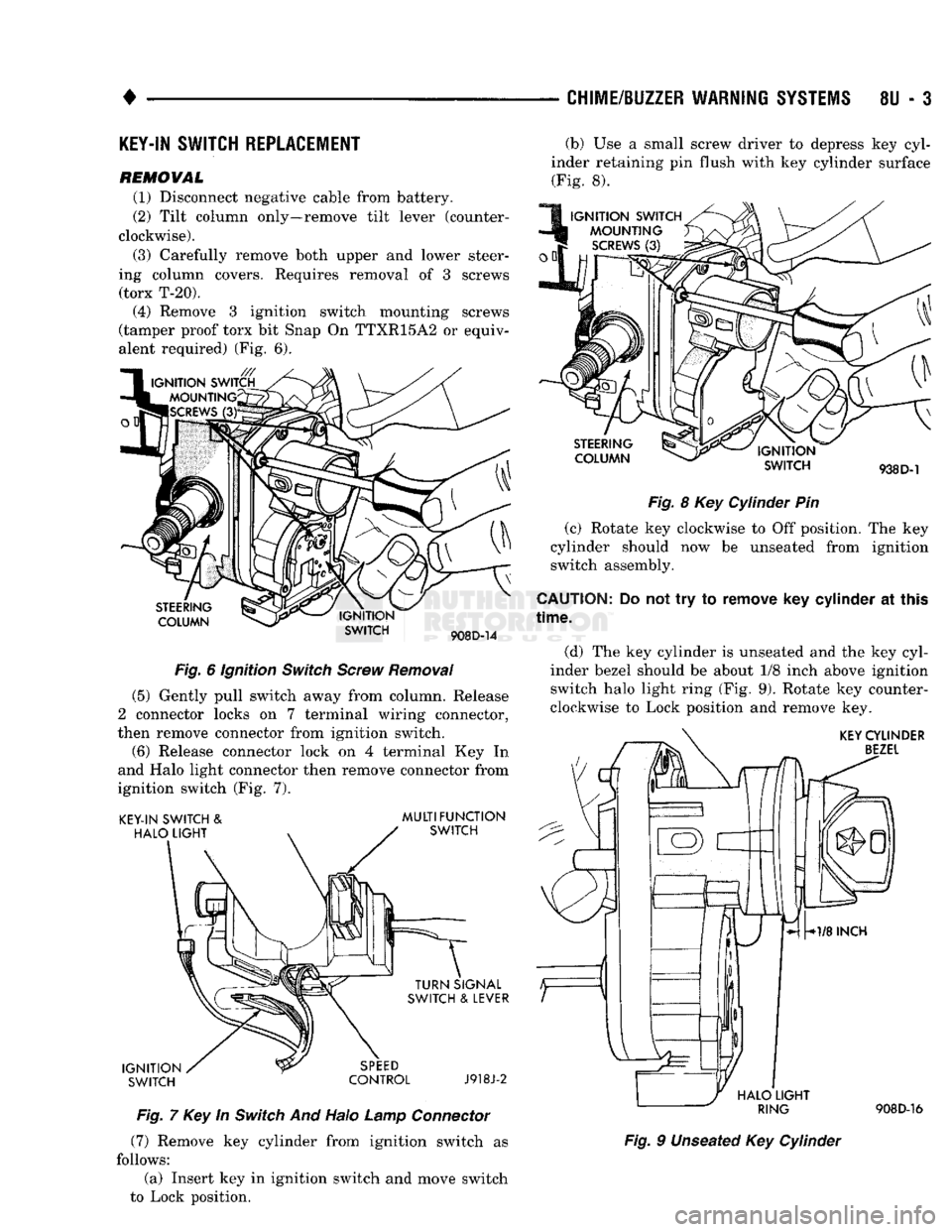
•
CHIME/BUZZER
WARNING
SYSTEMS
8U - 3
KEY-IN
SWITCH REPLACEMENT
REMOVAL
(1) Disconnect negative cable from battery.
(2) Tilt column only—remove tilt lever (counter
clockwise).
(3) Carefully remove both upper and lower steer
ing column covers. Requires removal of 3 screws (torx T-20). (4) Remove 3 ignition switch mounting screws
(tamper proof torx bit Snap On TTXR15A2 or equiv
alent required) (Fig. 6).
STEERING
COLUMN IGNITION
SWITCH
908D-14
Fig.
6 Ignition
Switch
Screw
Removal
(5) Gently pull switch away from column. Release
2 connector locks on 7 terminal wiring connector,
then remove connector from ignition switch.
(6) Release connector lock on 4 terminal Key In
and Halo light connector then remove connector from
ignition switch (Fig. 7).
KEY-IN SWITCH
&
HALO
LIGHT
MULTIFUNCTION
SWITCH
IGNITION SWITCH TURN SIGNAL
SWITCH
&
LEVER
SPEED
CONTROL
J918J-2
Fig.
7 Key In
Switch
And Halo
Lamp
Connector
(7) Remove key cylinder from ignition switch as
follows:
(a) Insert key in ignition switch and move switch
to Lock position. (b) Use a small screw driver to depress key cyl
inder retaining pin flush with key cylinder surface (Fig. 8).
IGNITION SWITCH MOUNTING
SCREWS
(3)
STEERING
COLUMN IGNITION
SWITCH
938 D-1
Fig.
8 Key Cylinder Pin
(c) Rotate key clockwise to Off position. The key
cylinder should now be unseated from ignition
switch assembly.
CAUTION:
Do not try to remove key cylinder at this
time.
(d) The key cylinder is unseated and the key cyl
inder bezel should be about 1/8 inch above ignition
switch halo light ring (Fig. 9). Rotate key counter
clockwise to Lock position and remove key.
KEY
CYLINDER
BEZEL
HALO
LIGHT
RING
908D-16
Fig.
9 Unseated Key Cylinder
Page 475 of 1502
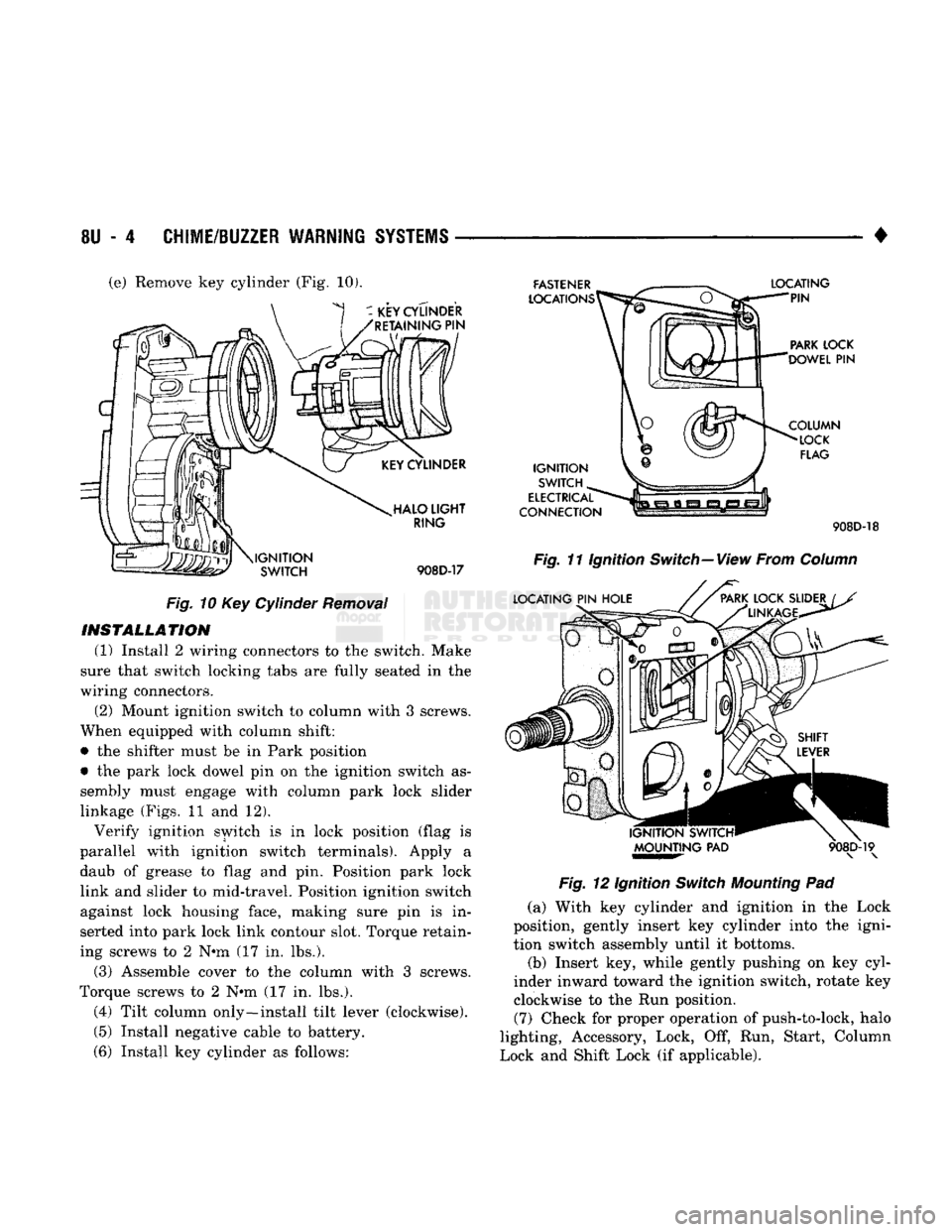
8U
- 4
CHIME/BUZZER WARNING
SYSTEMS
•
(e) Remove key cylinder (Fig, 10).
Fig.
10 Key Cylinder
Removal
INSTALLATION
(1) Install 2 wiring connectors to the switch. Make
sure that switch locking tabs are fully seated in the
wiring connectors.
(2) Mount ignition switch to column with 3 screws.
When equipped with column shift:
• the shifter must be in Park position
• the park lock dowel pin on the ignition switch as
sembly must engage with column park lock slider
linkage (Figs. 11 and 12). Verify ignition switch is in lock position (flag is
parallel with ignition switch terminals). Apply a daub of grease to flag and pin. Position park lock link and slider to mid-travel. Position ignition switch
against lock housing face, making sure pin is in
serted into park lock link contour slot. Torque retain
ing screws to 2 N*m (17 in. lbs.).
(3) Assemble cover to the column with 3 screws.
Torque screws to 2 N*m (17 in. lbs.).
(4) Tilt column only—install tilt lever (clockwise). (5) Install negative cable to battery.
(6) Install key cylinder as follows: 908D-18
Fig.
11 Ignition Switch—View From
Column
Fig.
12 Ignition
Switch
Mounting
Pad
(a) With key cylinder and ignition in the Lock
position, gently insert key cylinder into the igni
tion switch assembly until it bottoms.
(b) Insert key, while gently pushing on key cyl
inder inward toward the ignition switch, rotate key clockwise to the Run position. (7) Check for proper operation of push-to-lock, halo
lighting, Accessory, Lock, Off, Run, Start, Column
Lock and Shift Lock (if applicable).
Page 476 of 1502

•
WIRING DIAGRAMS
8W
- 1
CONTENTS
page page
COMPONENT IDENTIFICATION
.............
9
SPLICE LOCATIONS
29
GENERAL
INFORMATION
1
WIRING DIAGRAMS AD-BODY
37
GENERAL
INFORMATION
INDEX
page
Circuit
Identification
2
Component
Identification
3
Connectors
3
Fusible Links
3
Harness
Repair
3
Locating
A
System
or
Component
2
page
Secondary
Ignition
Wiring
1
Splice Locations
3
Symbols
and
Fuses
5
Troubleshooting
Wiring
Problems
3
Wire Code
Identification
2
Wiring
Diagram Sheets
and
Indexes
1
The wiring diagrams contain
the
latest information
available
at
time
of
publication. Throughout
out
this
group references
may
be
made
to a
particular vehicle
by letter
or
number designation.
A
chart showing
the
breakdown
of
these designations
is
included
in the
Introduction Section
of
this service manual.
SECONDARY
IGNITION WIRING
Secondary ignition wiring
is
shown
in
Figures
1
and 2.
For
information
on
ignition systems
or
distrib
utor operation refer
to
Group
8D
Ignition Systems.
SPARK
PLUGS
RIGHT
BANK
3.9L
SIX-CYLINDER
ENGINE
DISTRIBUTOR—CLOCKWISE
ROTATION
FIRING
ORDER
1-6-5-4-3-2
RN755
Fig.
1
Secondary
Ignition Wiring 3.9L
Engine
WIRING DIAGRAM SHEETS AND INDEXES
The wiring diagram sheets
are
organized
so
that
systems relating
to the
basic vehicle
and all of
its op
tions
are
shown. Add-on
or
non-factory options
are
SPARK
PLUGS
LEFT
BANK
EIGHT
CYLINDER
DISTRIBUTOR-CLOCKWISE
ROTATION
FOR
318
AND
360
CUBIC
INCH
ENGINES
FIRING
ORDER-1-8^-3-63-7-2 RP899 Fig.
2
Secondary
Ignition Wiring 5.2L and 5.9L
Engine
not covered.
The
diagram pages
are
identified
by a
sheet number which
is
located
at the
lower right
or
left hand corner
of
each sheet. Page numbers
at the
top
of
each page
do not
apply
to
diagram sheets.
Diagram sheets show
all
information relating
to
the system. This includes feeds, grounds, switch
in
ternal circuity, connectors, splices,
and
pin
identifica
tion
for
controllers
and
modules.
In certain instances
a
wire
may be
referenced
to
another sheet. When this happens,
the
wire will
be
identified
as to
where
it is
going.
The index used
for the
diagrams
is
located
at the
beginning
of the
diagrams.
It
covers
all
systems shown
in the
diagrams
and is in
alphabetical order.
WIRING
DIAGRAMS
Page 478 of 1502
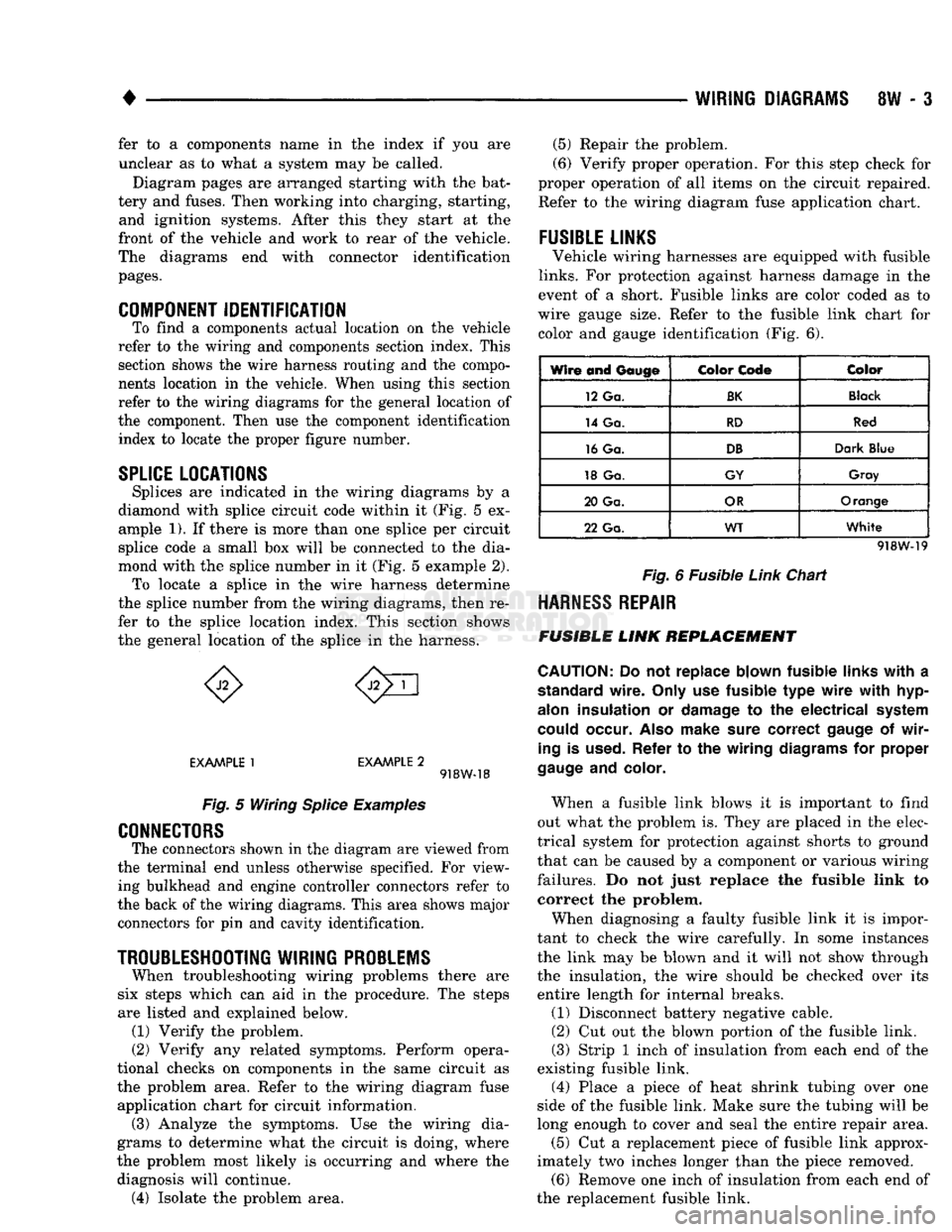
•
WIRING
DIAGRAMS
8W - 3 fer to a components name in the index if you are
unclear as to what a system may be called.
Diagram pages are arranged starting with the bat
tery and fuses. Then working into charging, starting, and ignition systems. After this they start at the
front of the vehicle and work to rear of the vehicle.
The diagrams end with connector identification
pages.
COMPONENT
IDENTIFICATION
To find a components actual location on the vehicle
refer to the wiring and components section index. This section shows the wire harness routing and the compo
nents location in the vehicle. When using this section
refer to the wiring diagrams for the general location of
the component. Then use the component identification index to locate the proper figure number.
SPLICE
LOCATIONS
Splices are indicated in the wiring diagrams by a
diamond with splice circuit code within it (Fig. 5 ex ample 1). If there is more than one splice per circuit
splice code a small box will be connected to the dia
mond with the splice number in it (Fig. 5 example 2). To locate a splice in the wire harness determine
the splice number from the wiring diagrams, then re
fer to the splice location index. This section shows
the general location of the splice in the harness.
EXAMPLE
1
EXAMPLE
2 918W-18
Fig.
5 Wiring
Splice
Examples
CONNECTORS
The connectors shown in the diagram are viewed from
the terminal end unless otherwise specified. For view ing bulkhead and engine controller connectors refer to
the back of the wiring diagrams. This area shows major connectors for pin and cavity identification.
TROUBLESHOOTING
WIRING
PROBLEMS
When troubleshooting wiring problems there are
six steps which can aid in the procedure. The steps
are listed and explained below. (1) Verify the problem.
(2) Verify any related symptoms. Perform opera
tional checks on components in the same circuit as the problem area. Refer to the wiring diagram fuse
application chart for circuit information. (3) Analyze the symptoms. Use the wiring dia
grams to determine what the circuit is doing, where
the problem most likely is occurring and where the diagnosis will continue. (4) Isolate the problem area. (5) Repair the problem.
(6) Verify proper operation. For this step check for
proper operation of all items on the circuit repaired. Refer to the wiring diagram fuse application chart.
FUSIBLE
LINKS
Vehicle wiring harnesses are equipped with fusible
links.
For protection against harness damage in the
event of a short. Fusible links are color coded as to
wire gauge size. Refer to the fusible link chart for color and gauge identification (Fig. 6).
Wire and
Gauge
Color
Code
Color
12 Ga.
BK
Black
14 Ga.
RD
Red
16 Ga.
DB
Dark
Blue
18 Ga.
GY
Gray
20 Ga.
OR
Orange
22 Ga.
WT
White
918W-19
Fig.
6 Fusible
Link
Chart
HARNESS
REPAIR
FUSIBLE
LINK
REPLACEMENT
CAUTION:
Do not replace blown fusible
links
with
a
standard
wire.
Only
use fusible type
wire
with
hyp-
alon
insulation or
damage
to the electrical
system
could
occur.
Also
make
sure
correct
gauge
of
wir
ing
is
used.
Refer to the wiring
diagrams
for proper
gauge
and
color.
When a fusible link blows it is important to find
out what the problem is. They are placed in the elec
trical system for protection against shorts to ground
that can be caused by a component or various wiring
failures. Do not just replace the fusible link to correct the problem.
When diagnosing a faulty fusible link it is impor
tant to check the wire carefully. In some instances
the link may be blown and it will not show through the insulation, the wire should be checked over its
entire length for internal breaks.
(1) Disconnect battery negative cable.
(2) Cut out the blown portion of the fusible link.
(3) Strip 1 inch of insulation from each end of the
existing fusible link.
(4) Place a piece of heat shrink tubing over one
side of the fusible link. Make sure the tubing will be
long enough to cover and seal the entire repair area.
(5) Cut a replacement piece of fusible link approx
imately two inches longer than the piece removed. (6) Remove one inch of insulation from each end of
the replacement fusible link.
Page 482 of 1502
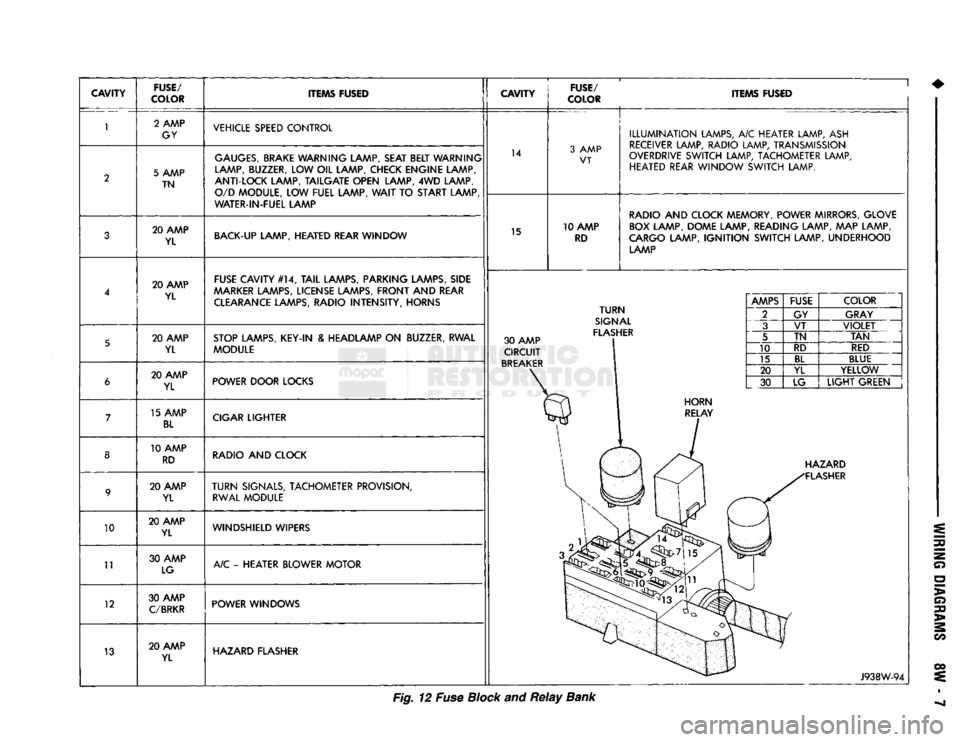
CAVITY
FUSE/
COLOR ITEMS FUSED
CAVITY
FUSE/
COLOR ITEMS FUSED
10
11
12
13 2 AMP
GY VEHICLE SPEED CONTROL
5 AMP TN
GAUGES,
BRAKE WARNING LAMP, SEAT BELT WARNING
LAMP, BUZZER, LOW OIL LAMP, CHECK ENGINE LAMP,
ANTI-LOCK LAMP, TAILGATE OPEN LAMP, 4WD LAMP, O/D MODULE, LOW FUEL LAMP,
WAIT
TO START LAMP
WATER-IN-FUEL LAMP 14
3 AMP
VT
20 AMP YL BACK-UP LAMP, HEATED REAR WINDOW
15 10 AMP
RD
ILLUMINATION
LAMPS, A/C HEATER LAMP, ASH
RECEIVER LAMP, RADIO LAMP, TRANSMISSION
OVERDRIVE SWITCH LAMP, TACHOMETER LAMP, HEATED REAR WINDOW SWITCH LAMP.
RADIO AND CLOCK MEMORY, POWER MIRRORS, GLOVE BOX LAMP, DOME LAMP, READING LAMP, MAP LAMP,
CARGO LAMP,
IGNITION
SWITCH LAMP, UNDERHOOD LAMP
20 AMP YL FUSE CAVITY #14,
TAIL
LAMPS, PARKING LAMPS, SIDE
AAARKER
LAMPS, LICENSE LAMPS, FRONT AND REAR CLEARANCE LAMPS, RADIO INTENSITY, HORNS
20 AMP YL STOP LAMPS, KEY-IN & HEADLAMP ON BUZZER, RWAL
MODULE 30 AMP
CIRCUIT
BREAKER
TURN
SIGNAL
FLASHER 20 AMP
YL POWER DOOR LOCKS
15 AMP
BL
CIGAR LIGHTER
10 AMP RD RADIO AND CLOCK
20 AMP YL
TURN
SIGNALS, TACHOMETER PROVISION,
RWAL MODULE
20 AMP YL WINDSHIELD WIPERS
30 AMP LG A/C - HEATER BLOWER MOTOR
30 AMP
C/BRKR
POWER WINDOWS
20 AMP YL HAZARD FLASHER
AMPS
FUSE
COLOR
2 GY GRAY
3 VT
VIOLET
5 TN
TAN
10 RD
RED
15
BL
BLUE
20 YL YELLOW
30 LG
LIGHT
GREEN HAZARD
FLASHER
J938W-94
Fig. 12 Fuse Block and
Relay
Bank
Page 492 of 1502
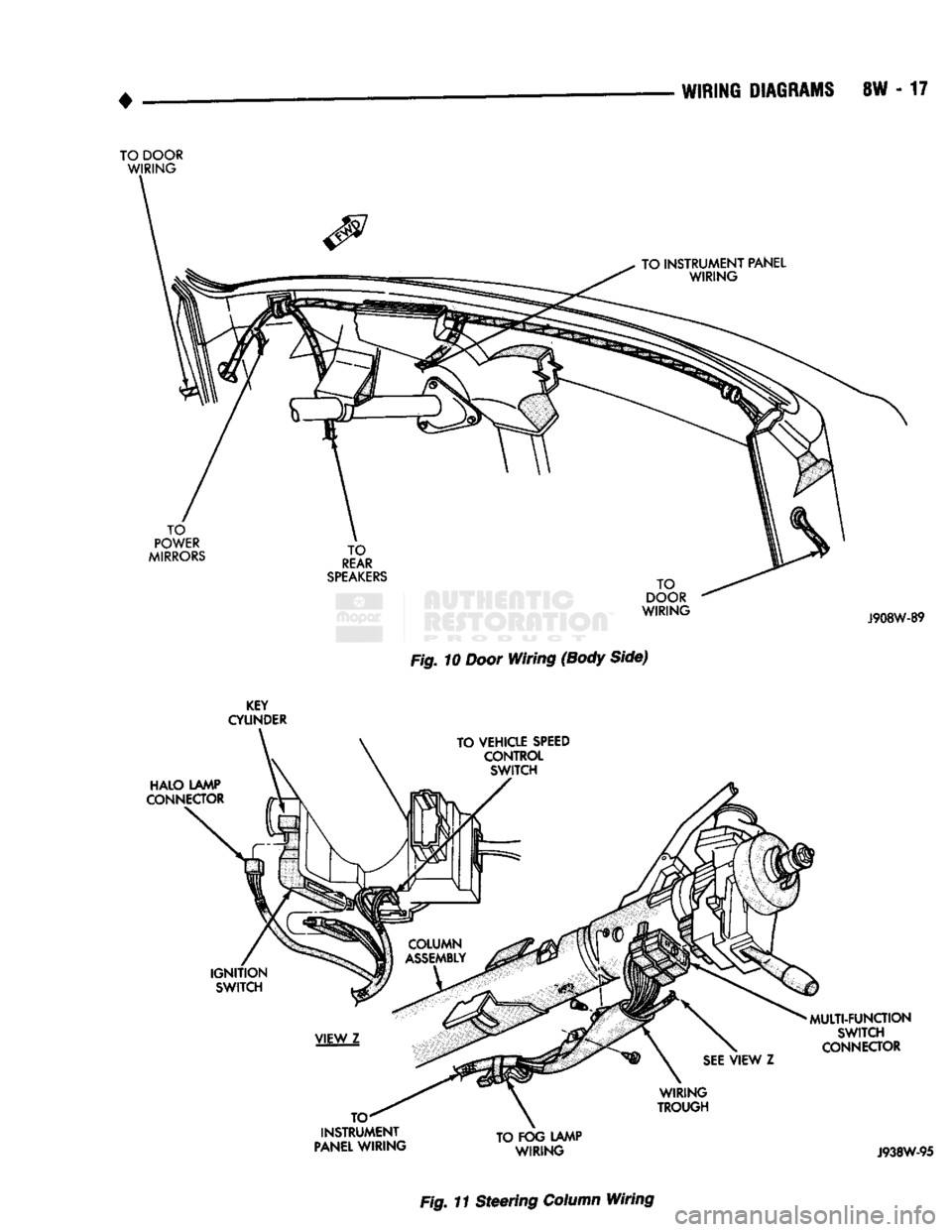
WIRING
DIAGRAMS SW - 17
TO DOOR WIRING
TO
POWER
MIRRORS
TO
REAR
SPEAKERS
TO INSTRUMENT PANEL
WIRING
TO
DOOR
WIRING
J908W-89
Fig. 10 Door
Wiring
(Body
Side)
KEY
CYLINDER
HALO LAMP
CONNECTOR IGNITION
SWITCH TO VEHICLE
SPEED
CONTROL SWITCH
SEE
VIEW Z MULTI-FUNCTION
SWITCH
CONNECTOR TO
INSTRUMENT
PANEL
WIRING WIRING
TROUGH
TO FOG LAMP WIRING
J938W-95
Fig. 11
Steering
Column
Wiring
Page 501 of 1502
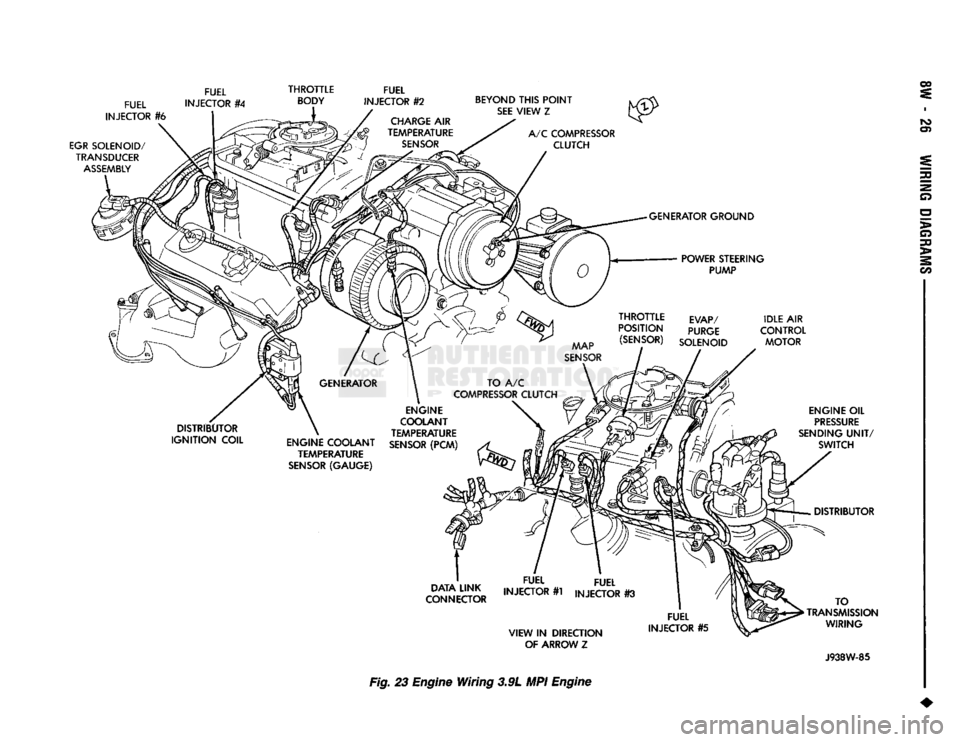
FUEL
INJECTOR
#6
FUEL
INJECTOR
#4
FUEL
INJECTOR
#2
BEYOND
THIS
POINT
SEE
VIEW
Z
EGR
SOLENOID/
TRANSDUCER
ASSEMBLY
A/C
COMPRESSOR
CLUTCH
GENERATOR
GROUND
POWER
STEERING
PUMP
AAAP
SENSOR
THROTTLE
EVAP/
POSITION
PURGE
(SENSOR)
SOLENOID IDLE
AIR
CONTROL MOTOR
TO
A/C
COMPRESSOR
CLUTCH
DISTRIBUTOR
IGNITION
COIL
ENGINE
COOLANT
TEMPERATURE
ENGINE
COOLANT
SENSOR
(PCM)
TEMPERATURE
SENSOR
(GAUGE)
ENGINE
OIL
PRESSURE
SENDING
UNIT/
SWITCH
DISTRIBUTOR
CONNER ,NJECTOR#1
INJECTOR
#3
VIEW
IN
DIRECTION OF ARROW
1
FUEL
INJECTOR
#5
TO
'TRANSMISSION
WIRING
J938W-85 INS
m
a
o
>
o
>
2
m Fig. 23 Engine
Wiring
3.9L MPI Engine
Page 502 of 1502

FUEL
INJECTOR
#8
FUEL
INJECTOR #4 FUEL
INJECTOR
#2
EGR
SOLENOID/
TRANSDUCER
DISTRIBUTOR
IGNITION
COIL
THROTTLE
BODY
CHARGE
AIR
TEMPERATURE
SENSOR
BEYOND
THIS
POINT
SEE
VIEW,
Z
TO
A/C
COMPRESSOR
CLUTCH ^DISTRIBUTOR
GENERATOR
GROUND
POWER
STEERING
PUMP ENGINE
OIL
PRESSURE
SENDING
UNIT/SWITCH
VIEW
IN
DIRECTION OF ARROW
Y
TO TRANSMISSION WIRING
THROTTLE
POSITION
(SENSOR)
IDLE AIR
CONTROL MOTOR
GENERATOR
ENGINE COOLANT
TEMPERATURE
SENSOR
(PCM)
ENGINE
COOLANT
TEMPERATURE
SENSOR
(GAUGE)
MAP
SENSOR
FUEL
INJECTOR
#3
EVAP/PURGE
SOLENOID
FUEL
INJECTOR #7
FUEL
INJECTOR.
#5
FUEL
INJECTOR
#1
A/C
CLUTCH VIEW
IN
DIRECTION
OF ARROW
Z
J938W-86
Fig.
24 Engine Wiring 5.2L and 5.9L MPI Engine o
>
30
>
2
w
oo !\3